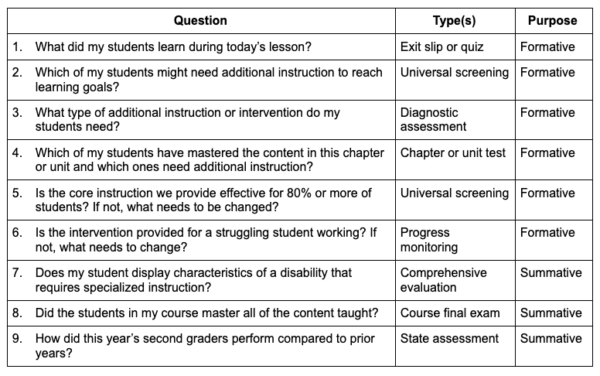Formative Assessment: What Is It and Why Use It
Formative assessment is widely used in schools. However, there are multiple definitions of this term. There can also be confusion around whether formative assessment is a process or a product.
What is Formative Assessment?
One popular way of thinking about formative assessment is that it in-forms instruction. The National Council on Measurement in Education (NCME) uses the following definition for formative assessment:
Formative assessment practices are those that provide teachers and students with information about learning as it develops—not just at the end of a project, unit, or year. The information is formative because it enables adjustments that deepen learning: Teachers use formative assessment to make adjustments to instruction, and students use the feedback from formative assessments to make revisions to their work and their approaches to it.
The NCME definition does not indicate if formative assessment is specifically a product or a process, yet hints at process when stating that it relates to “information about learning as it develops.”
The Council of Chief State School Officers (CCSSO) defines formative assessment as a process that involves both students and teachers.
Formative assessment is a planned, ongoing process used by all students and teachers during learning and teaching to elicit and use evidence of student learning to improve student understanding of intended disciplinary learning outcomes and support students to become self-directed learners. Effective use of the formative assessment process requires students and teachers to integrate and embed the following practices in a collaborative and respectful classroom environment:
-
- Clarifying learning goals and success criteria within a broader progression of learning
- Eliciting and analyzing evidence of student thinking
- Engaging in self-assessment and peer feedback
- Providing actionable feedback
- Using evidence and feedback to move learning forward by adjusting learning strategies, goals, or next instructional steps
The CCSSO definition includes guidance concerning effective formative assessment practices, further emphasizing that it is a process and not a product.
Formative vs Summative
To some extent, all assessments are part of a larger process of learning. However, formative assessment is often compared to summative assessment in order to distinguish key features.
One of the primary differences between formative and summative assessments is that formative assessments are conducted at multiple time points during learning, whereas summative assessment happens only at the end of the learning. Thus, the repetition of formative assessments confirms that it is a process. That said, an assessment could be used for both formative and summative purposes.
Examples of Formative vs Summative Assessment Purposes
There are many examples of formative assessments, each designed to answer a specific question about student learning. The following table displays types of assessments commonly used in schools with examples of their formative and summative applications. Note that some of the assessments listed serve the same purpose, and not all of them are necessarily used in one school.
Formative vs Summative Purposes

The defining feature of formative assessment is the action taken after the assessment to improve student learning. In this way, the data inform instruction. Formative assessments require a process in order to be helpful to students and teachers.
Summative assessments also provide important information about student performance, but the results are not used to modify individual student instruction. Instead, they are often used to review data from a group of students and identify patterns in performance by cohorts. In this regard, formative and summative assessments serve different purposes.
Use Formative Assessment for Formative Purposes and Summative Assessment for Summative Purposes
A formative assessment’s process depends on its function or purpose. An excellent way to define the purpose is by asking what question about student performance is the assessment designed to answer.
Here are common questions that teachers ask about student performance:
- What did my students learn during today’s lesson?
- Which of my students might need additional instruction to reach learning goals?
- What type of additional instruction or intervention do my students need?
- Which of my students have mastered the content in this chapter or unit and which ones need additional instruction?
- Is the core instruction we provide effective for 80% or more of students? If not, what needs to be changed?
- Is the intervention provided for a struggling student working? If not, what needs to change?
- Does my student display characteristics of a disability that requires specialized instruction?
- Did the students in my course master all of the content taught?
- How did this year’s second graders perform compared to prior years?
Some of the above questions are best answered with formative assessments and others by summative ones. The following table shows each of the above questions with the type of assessment best suited and whether the assessment is formative or summative.

Neither formative nor summative assessments are “best.” Instead, each type should be matched to the assessment purpose and the question(s) the test is seeking to answer.
Remember, formative assessment involves a process and many steps and tools are typically used during the process.
How to Evaluate Your Own Assessment System
A helpful activity that school leaders and teachers can do is to list all the assessments currently used in their school and then list the purpose for each assessment. Once all the assessments and their purposes are listed, it’s possible to see whether there are multiple tests used to answer the same questions.
Similarly, school leaders and teachers can list the questions they routinely ask about student performance and then match those questions to current assessments. If there are questions with no assessment, the team can discuss if it’s a question that must be answered or not. When it’s an essential question, an appropriate assessment should be selected to answer that question. Importantly, educators should strive to conduct as few assessments as possible to answer questions about student learning.
Support the Formative Assessment Process with Illuminate
Illuminate Education offers a number of assessment tools that educators can use to understand their students’ performance. Remember, formative assessment is a process that involves selecting and using assessments aligned to the question the teacher seeks to answer. The following list includes types of assessments, the questions they address, and which Illuminate tool best answers the questions.
- Just-in-Time/Short Cycle
- Confirms that specific learning has taken place and provides data to inform instruction that follows
- Examples: DnA
- Universal screening
- Informs Tier 1 instruction and intervention, informs which students may need interventions to succeed; informs system-level resourcing
- Examples: FastBridge
- Diagnostic assessment
- Informs specific intervention selection; diagnostic assessment ensures instructional supports are aligned to learning needs
- Examples: FastBridge
- Progress monitoring
- Informs intervention decisions and whether to continue, adjust, or fade supports
- Examples: FastBridge
- Interim
- Informs whether students are mastering grade-level content or if adjustments should be made to improve end of year outcomes
- Examples: DnA; SchoolCity
- Summative
- Informs system-level adjustments to curriculum, instruction, and assessment and scope and sequence to improve learning outcomes for all students
- Examples: DnA; SchoolCity
*****
Illuminate Education equips educators to take a data-driven approach to serving the whole child. Our solution combines comprehensive assessment, MTSS management and collaboration, and real-time dashboard tools, and puts them in the hands of educators. As a result, educators can monitor learning and growth, identify academic and social-emotional behavioral needs, and align targeted supports in order to accelerate learning for each student.
Ready to discover your one-stop shop for your district’s educational needs? Let’s talk.


